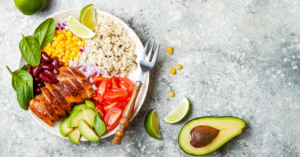While many people attribute their weight loss to exercise, it turns out that using an exercise routine really isn’t necessary for losing body fat.
Although that may sound counterintuitive to everything you’ve heard in the past, total weight and fat loss is actually due to creating what is known as a negative energy balance.
Fortunately, a negative energy balance can be accomplished via manipulation of many different variables, which may or may not include an exercise routine.
In this article, I’ll be discussing why exercise isn’t required for fat loss and then what other variables you should manipulate if your goal is to drop body fat.
(Whether your goal is to lose fat, build muscle, or maintain weight our macro calculator is a great place to start.)
Factors Influencing Fat Loss
Before getting into further specifics, it’s important to point out key variables associated with weight and, of course, fat loss. Understanding these principles is imperative if you want to change your body composition without using a sound exercise routine.
With hundreds of different messages out there about what’s important and what isn’t, it’s important to understand what variables need to be manipulated above all else for a successful body transformation.
At the top of that list is, naturally enough, the idea of energy balance. Energy balance is simply the theory that, in order to change your body weight, you’ll need to adjust energy balance, or the amount of calories you consume, relative to the number of calories you expend (1).
Interestingly, manipulating your energy balance can be accomplished via a number of different routes such as reducing calorie intake or by increasing calorie expenditure through your exercise routine, or, indeed, by a combination of both.
While the latter of those two variables can lead to energy expenditure, using an exercise routine, as a means of weight loss certainly is not essential and in many cases, not advised.
Manipulating your energy balance through diet and proper nutrition is definitely capable of providing the necessary stimulus for loss of weight and overall body fat.
Key Takeaways:
- Energy Balance is the most important consideration for weight and fat loss.
- Using an exercise routine to change your energy balance isn’t necessary.
- If you’re just looking to lose body fat, adjusting your calorie intake through restriction will suffice.
How Exercise Can Help or Hinder Your Weight Loss
Exercise is, of course, a great way to improve body composition and strength. Additionally, if used correctly, an effective exercise routine can provide a meaningful amount of calorie burn, aiding in weight loss attempts. However, that’s not always the best move.
One major issue with using exercise as a tool for weight loss is that many people tend to use exercise as an excuse to eat.
For example, many times I’ve seen friends, clients and even family “reward” themselves for their exercise session by consuming high-calorie foods like pizza and cheeseburgers because “they earned it.”
While there isn’t anything necessarily wrong with doing so, rewarding yourself for exercising with food can lead to terrible habits and, of course, accidental weight gain.
Many people actually overestimate the number of calories they burn through exercise. Additionally, many people also underestimate just how many calories they are consuming. Together, this combination of exercise and reward can result in accidental weight gain.
Key Point: Exercising can give you a false perception of calorie burn. In doing so, you may accidentally overestimate just how many calories you need or deserve.
Further, by rewarding yourself for training by eating, you could potentially be reinforcing the bad habit of consuming high-calorie foods, essentially reducing the benefits of exercising.
Lastly, there’s even evidence to suggest that your rigorous exercise routine may reduce your resting metabolic rate or the amount of calories you burn at rest. Essentially, you may burn extra calories through weight loss, but you may have a reduction of energy expenditure later on in the day, essentially equaling out (2, 3).
When this occurs, all of those “reward” calories can really begin to add up, resulting in weight gain, rather than a loss.
Rather than using exercise as a way to expend calories, followed by high-calorie rewards, focus on reducing your calorie intake through diet first, and then consider using exercise as a fallback, once weight loss stalls.
Key Takeaways:
- Exercising in addition to a diet can create bad habits of exercising and then rewarding one’s self.
- It’s likely you’ll overestimate just how many calories you’re burning through exercise, leading to accidental over-consumption of food.
- Chronic exercise when dieting can actually reduce your metabolic rate, putting you in a bad position to continue losing weight.
- Focus on reducing calories first before you start exercising for fat loss.
How Adjusting Nutrition Affects Your Fat Loss
When you adjust your energy balance by manipulating calorie intake alone, you’re essentially just taking calories away, while your body continues to burn a normal amount, despite the reduction.
In this case, your body is running on a higher amount of calories than you’re actually consuming. When this occurs, the body looks towards stored energy (glycogen, body fat and eventually muscle) to make up for the reduction of intake.
When this occurs and calories are expended, you begin to see a reduction in body weight. Additionally, if you’re reducing calories yet keeping protein high, it’s possible this weight loss will come from body fat stores.
Unfortunately, since many people commonly associate their exercise routine with calorie expenditure, these same people often believe that exercise is required for this to occur. But as you can tell, creating this reduction in calories can easily come from manipulating the amount and types of food you’re consuming.
Key Takeaway: If you’re trying to burn calories, the best option is to just reduce the amount of food your eating, rather than guessing how many you burn through exercise.
Food Quality Matters
Fortunately, adjusting your calorie intake through nutrition alone doesn’t need to mean starving yourself, as it once did in the past. Further, the days of thinking that you’ll have to consume only chicken and broccoli 5 times per day, fortunately, seem to be on their way out.
Focusing on calories and macronutrients, rather than the specific types of foods you’re eating has made waves in the fitness community as a way to lose weight, but also enjoy food again.
While doing so is certainly acceptable, sometimes people underestimate the power of consuming foods which are of high quality, yet are of a low-calorie density.
Focusing on low-calorie dense foods such as lean proteins and vegetables is a great way to inadvertently reduce calories, with little effort. Doing so is one of the main reasons many people find success using a “clean eating approach.”
When individuals use “clean eating”, they’re able to lose weight because of the low-density of calories, yet get a high volume of food. This creates an environment of eating more food, but reducing the actual amounts of calories being consumed, leading to weight loss.
Key Point: While calories are the most important factor, increasing the quality of your food is an easy and effective technique to reduce calories both during meals and during the rest of the day.
Additionally, focusing on lean proteins and vegetables for much of the diet is beneficial due to these ingredients being highly satiating, meaning you feel fuller for longer, reducing the chance of consuming extra calories due to hunger.
While protein’s 3-dimensional structure makes digestion slower, vegetables are often high in dietary fiber, which, in addition to helping digestion, also absorbs water, forming a gel in the stomach which slows food movement through the gut (4, 5, 6, 7).
Thus the digestion processes of these two foods combine to make you feel full after only consuming a reduced amount of calories. This also means you’ll be less likely to want to eat anything further after eating these ingredients.
Essentially, while the amount of calories you expend is most important, adjusting your nutrition to reduce both hunger and overall calorie intake can provide meaningful weight loss, even if you aren’t exercising at the same time.
Key Takeaways:
- Calories are most important but food quality can help you manipulate calories with ease.
- Focusing on ingredients like lean protein and increasing fiber intake through vegetables is a sure-fire way to lose weight without much effort.
Non-Exercise Activity Thermogenesis
If you’re not incorporating exercise into your routine due to lack of resources, time or just simply because it’s not your thing, one important factor of energy expenditure is what is known as NEAT or Non-Exercise Activity Thermogenesis.
As mentioned, your body burns calories, even at rest. Additionally, the body will burn calories through exercise as well, but what most seem to overlook are the calories that are burned the remainder of the time.
It’s important to remember that any action you take, whether it’s through explicit exercise or not, burns calories. Things like walking, washing the dishes, mowing the lawn and even just chewing gum all expend calories, which, over the course of days or months, can really begin to add up, leading to meaningful weight loss (8).
Fortunately, once you recognize that all other activities during your day expend calories, you can begin to manipulate these activities to be more effective.
One of the most common ways to increase NEAT is to opt for more difficult ways to complete everyday tasks. For example, opting for stairs over an elevator is a great way to expend more calories than you would normally burn.
Other tasks where this applies could include things like parking far from your office building, manually moving your grass, cleaning your house an extra time or even manually washing your car.
Once you begin implementing this technique, you can start to observe different tasks of your daily life and adjust them to be a bit more difficult, leading to increased calories burned.
While explicitly exercising isn’t a requirement for fat loss, improving NEAT can contribute to meaningful reductions in body weight and fat.
Key Takeaways:
- NEAT, otherwise known, as non-exercise activity thermogenesis is an often-overlooked method of burning calories.
- Increasing NEAT in your day is a perfect way to increase calorie burn without having to spend hours in the gym.
Why An Exercise Routine Isn’t Necessary To Lose Fat
While many attribute weight loss to their exercise routine, the truth is that exercise isn’t even necessary to lose fat. In fact, weight and fat loss can occur without ever stepping on a treadmill.
Weight and fat loss result from many different variables, all of which contribute to expending calories and creating what is known as a negative energy balance, a requirement for fat loss.
Fortunately, this negative energy balance can come as a result of calorie restriction, adjusting the types of food you’re eating or simply making everyday tasks like walking, just a little more difficult.
Overall, fat loss is entirely possible without even the simplest of exercise routines, you just need to know what variables should be manipulated and, of course, how to manipulate them.
The post Why An Exercise Routine Isn’t Necessary To Lose Fat appeared first on IIFYM.
from IIFYM Recipes and Articles – IIFYM http://ift.tt/2oQMj9N




No comments:
Post a Comment